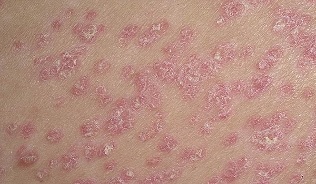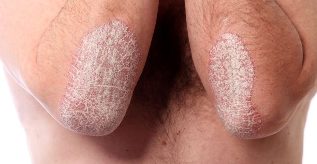Before the psoriasis, many patients do not immediately recognize the pathology, taking her by the allergic and rashes some other dermatitis. For the timely diagnosis of the disease, it is important to know how the flow of the pathology, what are the stages of psoriasis, and the manifestations of the disease in different stages. The course of psoriasis is characterized by four stages, among which highlight primary, progressive, the stationary phase and the appeal phase. More in detail each of the stages considered in the article.
The initial phase of psoriasis

Many people who care about the look of the psoriasis in the initial phase? See the first manifestations of the disease in the photo. To do this, it is typical of the phase of development in the skin characteristic of red, pink spots with well defined edges. The disease can occur in different parts of the body. Following grant's picture of the pathology in different parts of the body.
The symptoms of psoriasis in the initial phase of
For the initial phase of the disease are characterized by the following symptoms:
- slight desquamation of the dermis;
- the redness of the skin;
- the development of the itching;
- feeling of dryness, tightness;
- the formation of spots of different diameters;
- gradual strengthening of the peeling.
The clinical picture of the pathology may vary depending on the type of the disease. Thus, when the psoriasis in the form of droplets of size of the platelet has a little diameter, no more than 2 — 3 mm When the common vulgar, rashes grow to a large size, of more than 5 cm, often mixed between themselves, generating great lakes. For pustular psoriasis is typical of the education in the dermis of the cobalt-yellow or grayish tone with the influx of serous fluid beneath them.
The initial phase lasts in each patient differently. This depends on the species, the immunity of the patient and other features of the body.
The treatment of the initial phase
For the early stages of the disease is often prescribed the treatment of local rashes with the use of ointments, gels, lotions. Medical therapy aims to eliminate the itching, flaking, edema, redness, of the inflammatory process. To do this, apply hormonal and non-hormonal ointment.
Hormone medications in the initial stage is rarely prescribed. Often, their use is shown in patients with acute pathology.
Hormonal ointment often cause side effects. To use, it is recommended only under medical prescription.
The stage of psoriasis

The stage is characterized by the strengthening of the manifestations of the disease, the platelets are larger, itching, peeling, swelling, and inflammation intensifies. Eruptions in the skin begin to merge among themselves, hitting on the major parts of the dermis. In the stage of progress often appears to be a symptom of how the phenomenon of the kebnera. The essence of the phenomenon lies in the fact that new eruptions appear in places, damage in the epidermis. If the skin is scratched, abrasions, burns, in its place, with great probability, to appear plates. The duration of the phase forward average of 14 days to several months. In each patient during this period of time depends on the individual characteristics of the body and the rapidity with which the immunity to deal with the pathology.
The treatment of an advanced state
Acute during the psoriasis requires an integrated approach with the use of the following methods:
- The pharmacological treatment.
- The use of physiotherapy.
- Correction of style of life of the patient.
Important! The tactic of treatment is adjusted individually for each patient, and depends on the severity of the disease, the characteristics of the current and the presence of complications.
Processes medications
To get rid of platelets and the reduction of the symptoms of the disease in medical practice is used in the following groups of drugs:
- Antihistamines – designed in the reduction of these manifestations, such as itching, redness.
- Sedative medications allow for the withdrawal of the excess of stress, normalize sleep.
- The anti-inflammatory reliably removed from the process of inflammation, help remove redness, and other signs of the disease.
- Diuretics – drugs, calculated on the excretion of the body of surplus fluids and salt. These medicines help to cleanse the body, which influences positively in the course of the disease.
- Keratolytic – contribute to the good exfoliation of the epidermis, establishing the regeneration of the dermis, the update of the same.
- The immunomodulatory – regulate the immunity of the person, which is an important condition for recovery.
- Hormonal ointments, give a quick result, is mainly applied in severe disease.
- Cytostatic drugs – have the property of inhibiting the immune system, that it is sometimes necessary to get rid of psoriatic platelets.
All medications should be used only after consulting the doctor. The self-treatment, only get worse during pathology.
Physiotherapy
The techniques of physiotherapy are:
- Puva-therapy;
- The use of ultrasonic exposure.
- The magnetic therapy.
- Theory of therapy.
- The laser beams.
- Mud.
- Packages of applications.
- Sanatorium treatment.
The number of sessions and their length and picks up the doctor, taking into account the characteristics and the type of disease, as well as the personal qualities and general well-being of the patient.
Popular methods of

Therapeutic techniques recommended:
- The natural oils (juniper, or lavender). Have a healing effect and soothing, influence beneficially on the state of the skin. How to use: a few drops of oil add to the cream and fitted with put in eruption.
- Hydrogen peroxide (3%). Applies to equipped with a and is not removed. Before applying you should consult with a dermatologist.
- 30 g of propolis mixed with 250 ml of vegetable oil (olive oil prior to boiling). Cooked the mixture should be applied to the dissolution of the Horny layer of the epidermis and of the recovery of the elasticity of the skin.
- The bee's wax. This product has anti-inflammatory properties and attenuating effect. The bee's wax is necessary to melt it to base of water and steam, and then apply gently on the shell that covers the papules.
- The honey bee. The main product of the life of the bees has a positive influence on the organism of the person in the psoriasis. Should be consumed in limited quantities – 2 tablespoons per day.
The tincture psoriasis
Of the treatment techniques used the same oil and hydrogen peroxide.
They can add a dye to the base of the celandine. For its preparation you will need 3 tablespoons of this plant (dry or fresh) and salt water. In any case you can use the alcohol, which can dry out the skin.
How to prepare the remedy:
- the components should be mixed with each other;
- leave a couple of hours.
Before applying the tincture of the skin, it is recommended to use it in the tar of birch (equipped with one), to reinforce the effect.
For the therapy was effective, the patient must go to the health food, harmful products, causing the contribution to the state.
Diet for psoriasis

Patients with psoriasis, it is important to maintain a proper diet. The compliance of the diet more quickly clean the skin of the platelets, preventing the complication of the disease.
The principles of medical nutrition therapy the following:
- Forgoing the acute, salty, acidic, fried foods. These foods only increase the growth of platelets.
- The diet should be filled with a large amount of vegetables, fruits.
- In the main function of kitchen is best to choose cereals, soups, low-fat varieties of fish and meat.
- In the table should not be present in product allergens. We must give up eggs, nuts, chocolate, citrus fruits.
- Drinks with caffeine are also excluded.
- Non-alcohol, soft drinks.
- Dairy products should not contain fat. Preference should be given to the yogurt without additives, kefir, milk.
Take the food, it is recommended by the small portions, avoiding eating in excess. The diet is important, in charge of the therapy of the disease. Proper nutrition helps to satiate the hunger of vitamins, to get rid of slags and toxins.
The stationary phase of
It sets the stage is characterized by the decline in the growth of the psoriatic platelets, the amount in the body is not reduced, the disease as if it goes into sleep mode. If there are factors that cause the pathology of fixed, you can go back again in a phase of progress. The causes of this phenomenon it becomes a bad treatment, the breach of the diet, the lesions of the skin. The duration of the stationary phase is so different in different patients, that it was very difficult to think of even their borders. On average, the time that it takes from several weeks to several years.
The stage of regression
The stage of the regression is the final step before remission of the disease. Here we observe the following changes:
- The color of the papules of bright red colour enters into the pale pink shade.
- It decreases the amount of shedding.
- Be the itching.
- The skin is clean, it acquires a tone and smooth structure.
- In certain parts of the body are the so-called "officers of the platelet". Such eruptions completely do not pass, are stored in the skin, even in the period of remission.
Psoriasis refers to a chronic dermatitis, is not contagious. To completely get rid of the pathology on the day of today can not. The patients with the pathology, it is necessary for all life to continue prevention activities aimed at the prevention of recidivism. Many of the patients can be saved the period of remission in the next few years, leading a full life.























